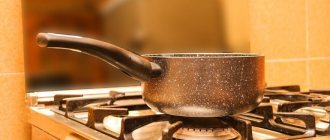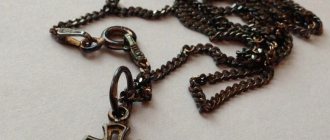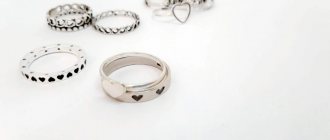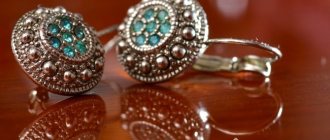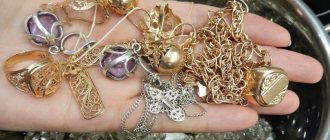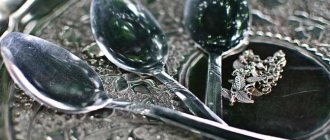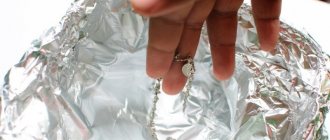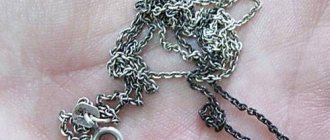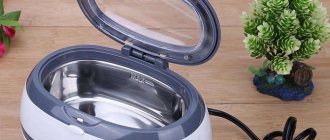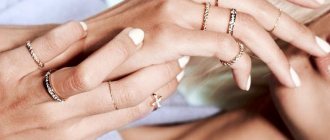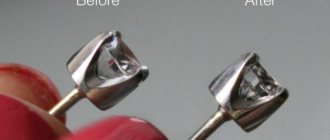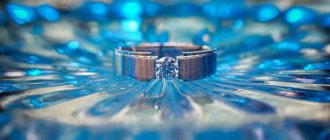Gold products tend to tarnish. The appearance deteriorates under certain conditions, for example, when they are exposed to an aggressive environment. However, this does not mean that the service life of the jewelry has expired. It is permissible to consider available means to restore the properties of the metal. One option is ammonia. It is used diluted or mixed with other components. You just need to choose an effective and fairly safe way to clean gold with ammonia. In order not to spoil the product, you should correctly determine the concentration of the product.
Ammonia and ammonia: what is the difference and what is the strength
It is a mistake to believe that ammonia and ammonia are synonyms, names of the same chemical substance. They have similar properties, but different intensity of impact on precious metals. Ammonia is a compound of nitrogen and hydrogen in gaseous form. It can turn into liquid at room temperature and a pressure of 8.5 atmospheres.
Ammonia in gaseous form participates in the biological cycle, but a pure substance of high concentration is toxic, has a poisonous, suffocating and even neurotropic effect. In comparison, ammonia is used much more widely. It is distinguished by a slightly aggressive effect on humans. The full name is ammonia.
This is an aqueous solution of ammonia, or more precisely, ammonium hydrate obtained from it (concentration - 10-25%).
Ammonia and ammonia for cleaning gold products
Lipstick
This method is practically unknown and little used among the people, so everyone is very surprised when they hear about it for the first time. At first it is not entirely clear how this is possible, and people are skeptical about it. But there are people who have tested it on themselves and done it quite effectively.
Women often accumulate a large amount of used or outdated lipsticks, and these can be used to great advantage for jewelry.
Many people ask why lipstick and what is it about it that helps clean gold from dirt. This is because it contains titanium dioxide, which is what copes with dirt.
To clean, you need to take the lipstick and rub it on earrings, gold chain rings and other items, then wipe with a regular dry cloth and rinse under the tap. The result will appear immediately. This is one of the fastest and easiest ways to restore your jewelry to its original condition.
Is it possible to clean gold using ammonia, is ammonia safe: advantages and disadvantages of the method
Considering the difference in properties and level of aggressiveness when exposed to materials and living beings, it is best to clean gold with ammonia, which has been further diluted. In this case, the original color of the metal is restored and other properties of the product are preserved. Pure ammonia is not used in everyday life - it is a gas. If it is dissolved in water, after some time the substance will lose its properties. What will remain is just technical fluid. For this reason, different recipes are used specifically based on ammonia.
Precautionary measures
When working with ammonia, given its characteristics as an excellent solvent and the presence of a pungent odor, we must not forget about precautions: the skin of the hands should in no case come into contact with the solution, since ammonia, being a solvent, can corrode the skin.
If the mixture accidentally ends up on it or on mucous membranes, you should immediately rinse the affected area with plenty of water, and then consult a doctor. Therefore, when cleaning the product, you must remember to wear rubber gloves; to remove the soaked product from the dish, you can use tweezers.
If it is necessary to clean tableware from blackness, it is advisable to replace ammonia with an alternative agent. If the product is poorly washed, the remains of ammonia may end up in the body and cause poisoning or burns.
One of the disadvantages of this method is the pungent odor, which is so dangerous that if you do not take precautions, inhaling the vapors can cause poisoning. Therefore, bending your head over an open bottle of ammonia, as well as breathing in vapors, is strictly not recommended. Fortunately, the unpleasant odor dissipates very quickly, so in order for the unpleasant odor to disappear as quickly as possible, cleaning should be carried out in a well-ventilated area.
Safety precautions when working with ammonia and ammonia at home
When choosing a method for cleaning gold with ammonia, safety measures are also studied:
- prepare gloves made of impermeable material (rubber), prepare a respirator or mask, and, if possible, wear safety glasses;
- the room should be well ventilated when handling alcohol;
- Do not allow the product to come into contact with the skin or mucous membranes.
It is not recommended to manipulate ammonia for people with impaired vascular function (for example, diagnosed with VSD). They are especially susceptible to volatile components in the vapor.
How not to clean jewelry?
Some common cleaning methods can seriously damage your gold. The easiest way - cleaning the jewelry with powder and a toothbrush - can remove the top layer of metal. In addition to many scratches, you can get unprotected metal, which can enter into a chemical reaction with air, sweat, water, and everything that surrounds an ordinary person.
Why is this happening? Some types of gold require a protective layer, which increases strength, protects against corrosion, improves the appearance of the metal and protects people from allergic reactions. For example, white gold. Not everyone can afford a high-quality alloy containing platinum. The cheaper option of white gold includes nickel, which can cause skin irritation.
White gold is coated with a layer of rhodium; careless cleaning can damage it.
Due to the allergenic properties of nickel, its use is prohibited in many countries. Externally, these two alloys are difficult to distinguish. To avoid unnecessary “sacrifice” from nickel, the products are plated with rhodium. It improves color and protects human skin from the unpleasant effects of nickel. By removing this protective layer with aggressive cleaning agents, a person exposes himself to danger.
Many jewelry have precious stones. Contrary to all beliefs, they are very fragile and need protection even more than gold. A completely harmless composition for cleaning gold can cause irreparable harm to the precious stone. Cleaning gold jewelry with ammonia can also damage the stones.
TOP 8 recipes with ammonia for gold shine
The cleansing effect is obtained by using ammonia of different concentrations with different components. Due to this, the properties of the resulting solution change, as well as the level of aggressive action.
Refined gold diamond ring
Cleaning with pure ammonia
Sometimes you can use undiluted ammonia (take a ready-made solution). Features of using this tool:
- prepare the container: glass or ceramics are suitable, plastic is the most neutral materials, they do not react with active compounds that can be formed when ammonia interacts with metal;
- they immerse gold jewelry in ammonia that needs to be restored to attractiveness;
- the products are left for several minutes or hours (depending on the complexity of the contamination), possibly from evening to morning;
- Remains of the substance from the surface of the jewelry are removed with water;
- clean with felt.
Important! Pure ammonia can be considered as a means for cleaning gold items that do not contain stones, without matte coating, with a minimum amount of impurities.
Cleaning gold jewelry
Recipe with water
Cleaning gold at home with ammonia is most often done using a less concentrated product. This method is suitable for cases where the contamination is weak or moderate. Brief instructions:
- Take dishes: made of glass, polymer material.
- Prepare a solution. The proportions of ammonia and water, respectively: 1 tsp, 250 ml.
- The gold is left in the working solution for 30 minutes.
- The products are washed and then dried with a lint-free cloth.
What causes gold to become contaminated?
Why does a once beautiful, shining product become dull and dirty? It's all about the impurities that are used to create jewelry.
Gold in its pure form is a very soft and abrasion-resistant material, the positive property of which is its resistance to corrosion and chemical influences of the environment.
Jewelry made from such material can be damaged simply by squeezing it in your hand. That is why various alloys are added to gold - metals, thanks to which the alloy becomes stronger and slightly changes its color. The ligature transfers some of its properties to the alloy and jewelers have the opportunity to make beautiful, designer, complex jewelry that amazes the eye with an abundance of complex and subtle elements.
The ligature not only gives different shades to gold, but also contributes to its rapid contamination.
Depending on the type of gold, various metals are added. To get yellow gold, just add silver and copper. Manganese, nickel, palladium or platinum makes gold white. The latter is the most expensive version of ligature. Copper gives gold its red color. The higher the copper content in the alloy, the brighter the color. Green gold contains silver or rubidium. Unusual black gold can be made by coating the surface with rhodium or ruthenium, or by oxidizing an alloy of gold, cobalt and chromium.
It is these additives that come into chemical contact with the environment, simultaneously changing the appearance of the jewelry. In addition to the chemical threat of oxidation, there is a threat of contamination of the product. Gold becomes covered with sweat and sebum, gradually losing its original magnificent appearance and shine.
Before you start cleaning, you need to understand that none of the home cleaning methods guarantees a 100% result.
Using a home cleaning method, you need to prepare for unpredictable results. If the product is as expensive as memory, it is better to rely on specialists.
Any cleaning product is designed for alloys, not for stones, so a product that is absolutely harmless to gold can negatively affect precious and semi-precious stones.
Many owners of jewelry do not understand their true composition. White gold can contain both platinum and nickel. Externally, the two alloys are practically indistinguishable for those who do not have professional skills. Platinum is much more resistant than nickel, which can be damaged by aggressive cleaning agents.
It is necessary to carefully clean gold jewelry, taking care not to damage the precious and semi-precious stones.
Any beautiful product has places that are hard to reach for cleaning. Cleaning your home may not completely remove dirt from some parts of the product. If it is fundamentally important to return the jewelry to its original appearance, it is best to contact a professional who can correct all the shortcomings that have appeared over time.
When starting to clean jewelry at home, the owner is fully responsible for the consequences of any recipes read. That is, he takes full responsibility for possible damage to a possibly important and expensive thing.
Any methods that involve scrubbing dirt from a product using a hard brush or powder will inevitably damage the jewelry. The original appearance returns, but not for long. These methods help get rid of the outer layer of dirt and at the same time erase the top layer of alloy from the jewelry, which protects the product from damage and corrosion.
The concentration of ammonia in solution and its dependence on the gold standard
To increase the hardness of gold, various additives are used, since this metal is quite soft in its primary form. Often, among the auxiliary components, silver and copper are considered the main ones. Their concentration can be different, which determines the shade of the patina when the finished product comes into contact with an aggressive environment (cosmetics, biological fluids).
Abrasive agents are not used to clean high-grade gold. The risk of damage is higher. For jewelry made from different types of gold, the appropriate recommendations are used.
Concentration of aqueous solution of ammonia for red gold:
- sample 375 – the upper limit is 15%;
- sample 585 – average 13%;
- sample 750 – the weakest possible, less than 5%.
Rules for wearing, care and storage of gold items
You can preserve the original beauty of jewelry by following simple rules for storing and wearing jewelry.
It is better to place jewelry in boxes with fabric upholstery so that the items do not come into contact with each other. You can use fabric bags for this. Prolonged exposure to sunlight and water should be avoided.
Basic wearing rules:
- Jewelry should be removed at night, when swimming, playing sports, cleaning, washing dishes, and using cosmetics.
- It is important to clean regularly.
Ammonia for gentle, effective cleaning of tough stains
When deciding whether ammonia is suitable for cleaning precious metals, you need to be aware of its effect on some items. For example, you cannot use aggressive substances to clean pearls, as well as other jewelry with organic stones. They will simply dissolve.
The ban also applies to products with a matte finish, since the surface layer is damaged. Ammonia cleans all other jewelry gently and in a short time.
Moreover, this product is used to eliminate the most complex contaminants.
Other folk methods
You don't have to suffer from the smell of ammonia or peroxide to clean yellow and rose gold. You can use other effective methods.
Available means
As the main component, you can use dishwashing detergent: a small spoon per 250 ml of water. Place a soft rag in the bottom of an enamel saucepan, dirty jewelry on top and fill them with the composition. Heat on low flame for 10 minutes. Then the jewelry must be removed and rinsed under running water, and wiped with a soft towel.
You can remove greasy deposits using a saline solution. You need three large spoons of powder in half a glass of water. After the grains are completely dissolved, place the products in the solution overnight. In the morning, you should thoroughly rinse and dry your jewelry.
You can deal with stains on gold using onion juice. Squeeze it onto a soft paper napkin, wipe the jewelry, rinse in running water and dry with a soft cloth.
Experimenting with unusual cleaners
You can clean the gold so that it shines brightly using foil mixed with two large spoons of soda. The last component is dissolved in a glass of water. The foil is placed on the bottom of a glass bowl, accessories are placed on top and “soda” is poured over. The purification process takes place over 12 hours, after which the gold is thoroughly washed and dried with a soft cloth.
Heavy contaminants are removed with borax solution:
- Soak a piece of natural silk in the mixture.
- Use light movements to polish the jewelry.
- Rinse thoroughly.
After washing, rub until shiny with a clean piece of silk.
Gently and without scratches clean the noble metal with lipstick. It should be a light shade. The lipstick is simply applied to the jewelry without stones and polished with a velvet scrap.
An egg-beer cocktail has an excellent effect on metal surfaces. Whisk an egg white with a spoon of beer, wet a piece of soft wool with it and simply remove dirt from gold jewelry.
Abrasives
Mechanical cleaning is not suitable for jewelry with stones.
If none of the proposed methods yielded results, and the dirt remains, mechanical action cannot be avoided. Abrasive pastes are not used for products with precious stones or coating, since the surface of jewelry and stones is very easy to scratch. Cubic zirconia stones especially suffer from such cleaning. But smooth rings and bracelets can be “offered” a kind of peeling.
To prepare an abrasive composition with your own hands, you will need:
- toothpaste without dyes;
- petrolatum;
- crushed chalk;
- grated laundry soap;
- water.
The resulting paste is applied to the decoration with a soft cloth. Once completed, you need to rinse the gold item to remove the Vaseline. At the end, the product is additionally rinsed under water and dried.
If you want more effective cleaning, you can add alcohol to the composition and slightly heat the water.
A good scrub for gold jewelry would be regular tooth powder. It is also diluted to a paste-like state:
- Mix four large spoons of powder with a little water.
- Dip your toothbrush into the resulting paste.
- Clean your earrings and rings with it.
- Rinse with clean water.
Don't forget to wipe your jewelry dry.
Sugar peeling is done for white gold accessories. The sweet product will quickly remove blackness and dirt. To do this, you need to dissolve two tablespoons of sugar in a glass of water. Place the products in sugar syrup for 10–12 hours: this will return them to their former shine and shine.
White gold is composed of an alloy of three metals: nickel, gold and copper. The coating is usually made of rhodium. The surface of such jewelry can wear off quickly, so they must be cleaned gently and gently.
Reviews
When I was getting ready to clean gold, I learned that jewelry with stones on it can be ruined. I began to look for a method that suits them. It turned out that “Fairy”, salt and ammonia can solve the problem. The components are taken in a 1:1 ratio. But just don't leave the gold in the mixture. It is applied to a ring or bracelet, and then cleaned with a soft brush, perhaps a toothbrush, for example. Moreover, salt is needed with small particles.
Angela Gusina, Krasnodar
Maria Ivanova, Moscow
I don’t bring my jewelry to such a state that it requires using “heavy artillery” means. From time to time I use peroxide and ammonia and add hot water. The result is good, most importantly, the reaction is fast.
I found an old ring, long lost at home. It had darkened and it was impossible to wear it. To clean, I took ammonia and shampoo - everything I found at home. The remedy works, but not quickly enough. I decided to also try a peroxide-based solution. This option removed the darkening in a shorter period of time.
Nadezhda Rimskaya, Leningrad
Cleaning blackened silver at home
Blackened silver is rarely found in jewelry stores, but it is plentiful at flea markets and in grandma's chests. A touch of antiquity will give the product nobility, but a touch of dirt and dust - not so much. You can clean black silver with soda and salt and a cleaning agent, a regular school eraser, or ammonia with crushed chalk. There is no guarantee that the product will regain its original shine, but it will look much fresher and cleaner.
